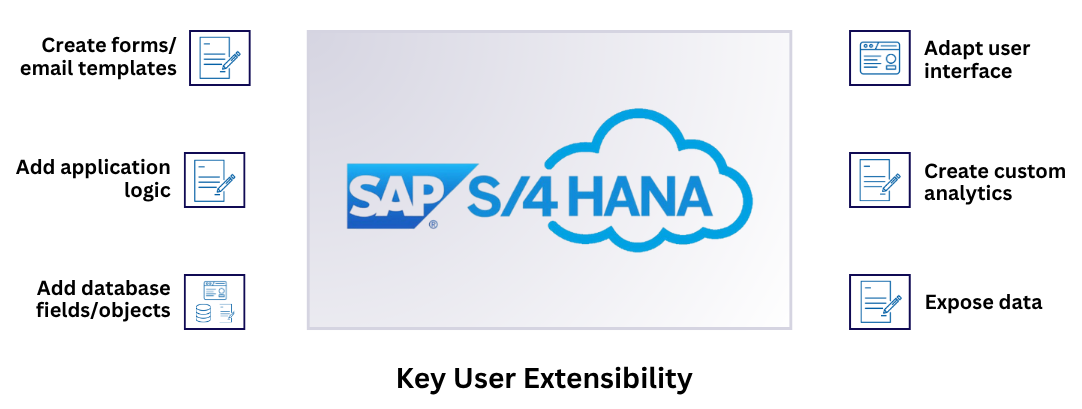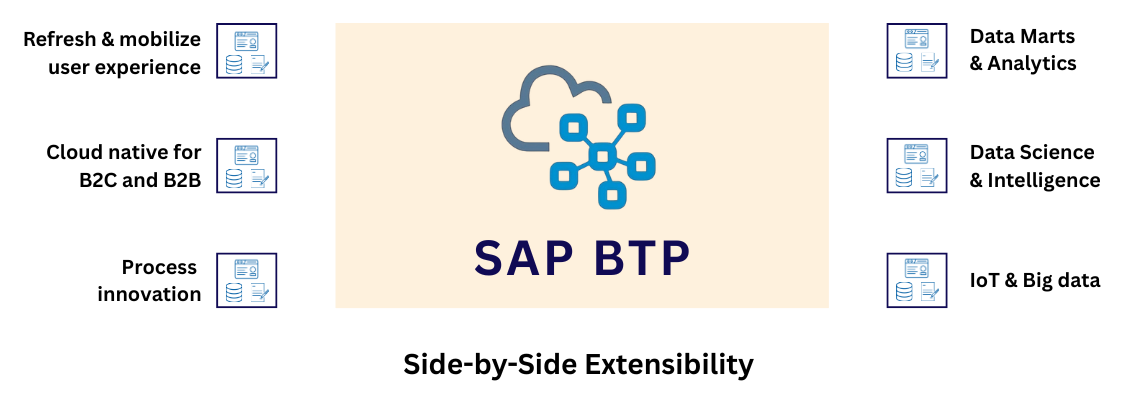The term "digital transformation" has become clichéd, dominating strategy discussions and boardroom conversations, but many companies still struggle to make it a reality. Digital transformation is not just about moving data to the cloud or switching to new Software. Instead, it is like renovating an old house while still residing there. You want to modernize every room, fix what is broken, and improve how everything connects.
For businesses running on outdated systems, that's no small task. Legacy platforms, fragmented data, and increasing customer demands make innovation difficult. This is where a modern, intelligent ERP system comes in
This blog post explains how SAP's public cloud ERP solution, based on S/4HANA, modernizes and simplifies business processes.
What is SAP S/4HANA Public Cloud?
This is a cloud-based ERP platform designed to help companies standardize and automate their core business processes using industry best practices.
Companies in industries such as manufacturing, healthcare, energy, and consumer goods use this solution to manage their Lead-to-Cash or Design-to-Operate cycles more efficiently.
As a SaaS solution, the infrastructure is managed by SAP while businesses focus solely on their core operations.
Key Features
SAP S/4HANA Public Cloud helps businesses run more efficiently and adapt quickly to change. Below are some of its standout features:
- Embedded AI: It provides AI-driven insights and suggestions due to its embedded AI.
- Data management: By centralizing and harmonizing data, the ERP system provides safe, precise, and decision-making support.
- Automated processes: Reduce manual labor using artificial intelligence and machine learning to streamline operations.
- Reduced IT workload: It reduces the amount of work that the IT team must do. Therefore, businesses don't require an extensive infrastructure.
- Real-time Insights: It provides real-time analytics, which enables fast data-driven decision-making.
Business Benefits
Organizations that adopt this solution realize the following benefits:
- Fast time to value: Companies can speed up implementation by applying best-practice configurations.
- Extensibility: You can easily integrate with partners and expand your ERP system using APIs.
- Improved business outcomes: S/4HANA Public features AI and analytics, which help to improve business outcomes.
- Regular updates: SAP ensures business continuity by performing system updates and maintenance on a regular basis.
Architecture Overview
.png)
SAP S/4HANA Public Cloud uses a multi-tenant SaaS architecture where multiple customers securely share the same infrastructure. At its foundation lies the SAP HANA in-memory database, which processes vast volumes of data in real time
At the top layer is the responsive and user-friendly SAP Fiori user interface through which users interact with the application. To ensure secure access, users are authenticated via Identity Access Management.
After authenticating, users can carry out business operations. The Application Layer processes these actions by retrieving or updating business data stored directly in the SAP HANA Database.
For customization to unique business needs, the SAP Business Technology Platform (BTP) enables side-by-side extensions and integrations with third-party systems, ensuring a unified and intelligent business environment without modifying the core S/4HANAsystem.
For decision-making, the SAP Analytics Cloud taps into real-time data to deliver actionable insights and visualizations that help businesses stay ahead. All these layers are supported by an elastic cloud infrastructure, which guarantees high availability and scalability.
Extensibility
Every company always wants to stay ahead of its competitors, and this requires out-of-the-box solutions. Extensibility plays a primary role in achieving this purpose. How? by allowing companies to adapt S/4HANA Public Cloud to their specific needs. It does this without affecting the stability of the core system. The extensibility feature enables SAP partners and customers to integrate third-party systems, customize apps, and expand functionality while keeping the system upgrade-safe.

The following extensibility options allow an SAP developer or functional user to customize S/4HANA Cloud to specific business requirements:
Key-User Extensibility
It enables a functional user to add simple extensions to the Cloud ERP system. The user does not need to have technical knowledge, such as coding, to make a change.

Key-User extensibility is ideal for functional users who want to:
- Customize the user interface
- Create custom CDS Views
- Define custom business objects
- Create forms
- Add custom business logic
Developer Extensibility
Developers can create upgrade-safe custom functionalities within the S/4HANA cloud environment by using a cloud-optimized subset of the ABAP language and released SAPAPIs. Developer extensibility is ideal for:
- Building custom SAP Fiori apps
- Developing Web UIs based on OData services
Side-by-Side Extensibility
The developer can build and run custom apps on the SAP Business Technology Platform using runtimes such as ABAP, Java, or Node.js. It is ideal for loosely coupled extensions built outside the S/4HANA environment. Side-by-side extensibility is scalable and minimizes risk to the core system by allowing users to:
- Use events and APIs to link external apps.
- Expose OData and HTTP services via the Cloud Connector
- Run automation and AI as microservices.

Implementing S/4HANA Public Cloud
The preferred and officially recommended framework for this implementation is the SAP Activate Methodology.
What is SAP Activate Methodology?
SAP Activate Methodology is an agile and phased approach designed primarily to accelerate all S/4HANA implementations.
Six Phases of Activate Methodology
The SAP Activate Methodology comprises six phases, each with specific tasks and tools that guide the project's success from start to finish.

- Discover: This is where you gain an understanding of S/4HANA and how it meets your specific business requirements.
- Prepare: In this phase, you initiate the project plans, set up the technical environment, and conclude the project plans.
- Explore: It involves a Fit-to-Standard workshop where you compare your processes with SAP standard processes. The objective is to identify gaps.
- Realize: In this phase, you implement the necessary configuration on the system based on the identified gaps and defined scope. Here, you also validate the configuration by conducting system testing.
- Deploy: In the deploy phase, you carry out the cutover activities to transition to the new system.
- Run: Your system goes live. Consequently, you focus on its continuous improvement
Underlying approaches behind the Activate Methodology
The Activate methodology has six key phases. However, it is crucial to understand the underlying approaches that guide its implementation, especially when considering S/4HANA Public Cloud.
Fit-to-Standard & Cloud-ready Mindset
SAP Activate adopts a Fit-to-Standard and cloud-ready mindset. It substitutes conventional requirements gathering with Fit-to-Standard workshops during the explore phase. Instead of creating unique solutions from the ground up, this approach encourages businesses to align with SAP pre-delivered best practices.
The SAP Central Business Configuration tool helps you configure best practices and push the configurations into the cloud system.
Importance
The importance of Fit-to-Standard & Cloud-ready Mindset are:
- Faster implementation cycles
- Minimized implementation risk
- Smooth upgrade
- Cloud-ready and Scalable
Agile and Iterative Delivery
SAP Activate also supports agile principles by breaking the implementation into manageable sprints. Sprint allows teams to configure, continuously test, and validate the solution iteratively, rather than waiting until it is complete. Sprint requires teams to adapt to change.
Tools such as SAP Activate Roadmap Viewer and SAP Cloud ALM can guide and help with your agile project management.
Importance
The importance of Agile and Iterative Delivery are:
- Accelerates the feedback loop
- Promotes stakeholders engagement
- Early identification and resolution of challenges
Business Driven Transformation
SAP Activate promotes early alignment among business and IT teams. This alignment leads to tangible business outcomes. SAP Signavio Process Insights provides insights about your process performance, and areas that need improvement.
Conclusion
SAP’s public cloud ERP helps businesses run faster. It comes with built-in AI, real-time insights, and a cloud-based setup that reduces the need for heavy IT work. Companies can easily customize it using different extension options without breaking the core system. With the SAP Activate methodology, businesses can follow a clear, step-by-step process to implement the solution quickly and effectively. Whether you're in business or IT, this cloud ERP helps you stay agile, improve processes, and be ready for the future.
FAQs
How does SAP S/4HANA Public differ from Private editions?
The S/4HANA Public Cloud is standardized and multitenant, indicating that multiple users share the same cloud infrastructure. Additionally, it provides frequent automatic updates. However, S/4HANA Private Cloud provides dedicated infrastructure and more customization with managed updates.
What are the main advantages of S/4HANA Public Cloud?
Faster deployment, lower TCO, best practice configurations, and advanced capabilities such as AI and analytics..
How secure is my data?
SAP ensures security through data encryption and compliance with global standards, including ISO and GDPR.
What is developer extensibility?
Simply put, developer extensibility ensures that any custom extensions a developer builds stay stable and work safely during upgrades in the S/4HANA cloud environment.
Do you want to
learn more about integration?
We are dedicated to make our knowledge accessible. You can either figure it out by yourself or you can let us give you a hand.
Let us take care of your integration.
We are SAP Certified and we can make your project happen. Explore our services and contact us. We will be happy to take on your project.
View Our Services
-modified.png)

